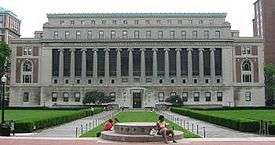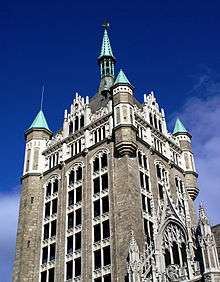Education in New York
The University of the State of New York (USNY) (distinct from the State University of New York, known as SUNY), its policy-setting Board of Regents, and its administrative arm, the New York State Education Department, oversee all public primary, middle-level, and secondary education in the state. The New York City Department of Education, which manages the public school system in New York City, is the largest school district in the United States, with more students than the combined population of eight U.S. states. Over 1 million students are taught in more than 1,200 separate schools.
Primary and secondary schools
| Education in the United States |
|---|
|
|
Public secondary education consists of high schools that teach elective courses in trades, languages, and liberal arts with tracks for gifted, college-bound and industrial arts students. New York is one of seven states that mandate the teaching of Holocaust and genocide studies at some point in elementary or secondary school curricula.
One of the major public policy issues in recent decades has been the attempt by poorer communities to get more state funding to compensate for what they cannot generate in property taxes. The reliance of most communities on local property taxes to support schools has created the paradoxical situation of residents in wealthier communities paying a lower tax rate than residents in communities of lower average income.
While state law has required integrated schools since 1900 (overturning an 1894 law that permitted communities to establish separate schools for children of African-American descent[1]), patterns of residential segregation in many areas has often led to de facto segregated schools. As studies have shown the importance of integrating children from different economic classes, more than ethnic groups, communities are devising different methods, such as magnet schools, to deal with attracting diverse groups of students.
Charter schools
As of 2013, there were 183 charter schools serving 70,000 students in the state.
History
Between 2000 and 2009, school enrollment declined by 121,000 students, and the number of teachers increased by 15,000. The student:teacher ratio was the eighth lowest in the country, 13:1. At $16,000, its per student spending was the nation's highest.[2]
Colleges and universities
The SUNY System

New York's statewide public university system is the State University of New York (SUNY), which includes top-ranked schools such as Binghamton University, Stony Brook University, and University at Buffalo. With a total enrollment of 459,550 students and 1.1 million continuing education students spanning 64 campuses across the state, SUNY is the largest comprehensive public university system in the United States. The campuses are a mix of community colleges, technical colleges, undergraduate colleges, and doctoral-granting institutions, with the latter including the four university centers (University at Albany, Binghamton University, University at Buffalo, and Stony Brook University).
The SUNY system includes the following campuses, broken down into the categories of University Centers, other doctoral-granting institutions including five statutory institutions, Comprehensive Colleges, Technology Colleges, and Community Colleges.
Doctoral-Granting Institutions
University Centers
Other doctoral-granting institutions and statutory colleges
- State University of New York College of Environmental Science and Forestry (next to the private Syracuse University campus, with which it has a close working relationship, but which is legally and technically not a part of)
- SUNY College of Optometry
- SUNY Downstate Medical Center
- SUNY Polytechnic Institute
- SUNY Upstate Medical University
One statutory college at Alfred University:
- New York State College of Ceramics (which is legally and technically part of Alfred University)
Four statutory colleges at Cornell University (which are legally and technically part of Cornell):
- New York State College of Agriculture and Life Sciences (CALS)
- includes the New York State Agricultural Experiment Station at Geneva, New York
- New York State College of Human Ecology (HumEc)
- New York State School of Industrial and Labor Relations (ILR)
- New York State College of Veterinary Medicine
Comprehensive Colleges
- Buffalo State College
- State University of New York College at Cortland
- Empire State College (statewide)
- State University of New York at Purchase
- State University of New York at Geneseo
- State University of New York College at Oneonta
- State University of New York at Fredonia
- State University of New York at New Paltz
- State University of New York at Oswego
- State University of New York at Potsdam
- State University of New York at Plattsburgh
- State University of New York at Old Westbury
- State University of New York at Brockport
Technology Colleges
- Alfred State College
- State University of New York at Canton
- State University of New York at Cobleskill
- State University of New York at Delhi
- Farmingdale State College
- State University of New York Maritime College
- Morrisville State College
- Fashion Institute of Technology
Community Colleges
- SUNY Adirondack Community College
- Broome Community College
- Cayuga Community College
- Clinton Community College
- Columbia-Greene Community College
- Corning Community College
- Dutchess Community College
- Erie Community College
- Finger Lakes Community College
- Fulton-Montgomery Community College
- Genesee Community College
- Herkimer County Community College
- Hudson Valley Community College
- Jamestown Community College
- Jefferson Community College
- Mohawk Valley Community College
- Monroe Community College
- Nassau Community College
- Niagara County Community College
- North Country Community College
- Onondaga Community College
- Orange County Community College (SUNY Orange)
- Rockland Community College
- Schenectady County Community College
- Suffolk County Community College
- Sullivan County Community College
- Tompkins Cortland Community College
- Ulster County Community College
- Westchester Community College
The CUNY System
The City University of New York (CUNY) is the public university system of New York City and is independent of the SUNY system. It is the largest urban university in the United States, with 11 senior colleges, 6 community colleges, a doctorate-granting graduate school, a journalism school, a law school and the Sophie Davis School of Biomedical Education. More than 450,000 degree-credit, adult, continuing and professional education students are enrolled at campuses located in all five New York City boroughs.

CUNY consists of the following 21 colleges, including the senior colleges, community colleges, graduate and professional institutions.
Senior Colleges
- City College of New York
- Hunter College
- Baruch College
- Brooklyn College
- Queens College, City University of New York
- New York City College of Technology
- College of Staten Island
- John Jay College of Criminal Justice
- York College, City University of New York
- Lehman College
Community Colleges
- Bronx Community College
- Queensborough Community College
- Borough of Manhattan Community College
- Kingsborough Community College
- LaGuardia Community College
- Hostos Community College
Graduate and professional schools
- CUNY Graduate Center
- Sophie Davis School of Biomedical Education
- CUNY School of Law
- William E. Macaulay Honors College
- CUNY Graduate School of Journalism
- CUNY School of Professional Studies
- CUNY School of Public Health
Private universities
New York has hundreds of private colleges and universities, including many religious and special-purpose institutions. The state's land-grant university is Cornell University; though primarily a private institution, it has public sectors.
Two of the nation's five Federal Service Academies are located in New York: the United States Military Academy at West Point and the United States Merchant Marine Academy at Kings Point.
New York attracts the most college students from other states, according to statistics that show that among freshmen who leave their home states to attend college, more come to New York than any other state, including California.[3]
In total, New York State has 307 degree-granting institutions, second in number only to California. Among the most notable and highest ranked institutions are:
- Bard College
- Clarkson University
- Canisius College
- Colgate University
- Columbia University
- Cooper Union
- Cornell University
- Culinary Institute of America
- Dominican College
- Elmira College
- Fordham University
- Hamilton College
- Helene Fuld College of Nursing
- Hobart and William Smith Colleges
- Hofstra University
- Ithaca College
- Manhattan College
- Marist College
- New York Institute of Technology
- New York University
- Pace University
- Pratt Institute
- Rensselaer Polytechnic Institute
- Rochester Institute of Technology
- Sarah Lawrence College
- Skidmore College
- St. Bonaventure University
- St. John's University
- St. Lawrence University
- Syracuse University
- Union College
- University of Rochester
- Utica College
- Vassar College
See also
- Government of New York (state)
- Education in New York City
- List of colleges and universities in New York
References
- ↑ Martha A. Sandweiss, Passing Strange: A Gilded Age Tale of Love and Deception Across the Color Line, New York: Penguin Press, 2009, pp. 213
- ↑ Will, George F. (6 June 2010). "Column:the teacher bailout". Washington, DC: Washington Post. pp. A15.
- ↑ "New York, College Town.", The New York Observer

